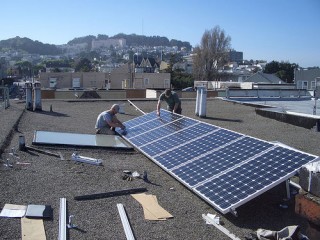One megawatt at DuPont and one megawatt at Valdosta’s Mud Creek Wastewater Treatment Plant: that’s two more megawatts of solar power coming to Valdosta and Lowndes County! This was revealed at the 16 April 2013 Board Meeting of the Valdosta-Lowndes County Industrial Authority.
 Project Director Allan Ricketts was on a speaker phone,
so Executive Director Andrea Schruijer gave the
Existing Industry and Project Report.
She thinks maybe three existing industry expansions in second and third quarter 2013.
They’ve continued working with a pharmaceutical company about locating here;
more on that later.
Continued work with three renewable and sustainable energy companies,
and Georgia Power is cooperating.
Project Director Allan Ricketts was on a speaker phone,
so Executive Director Andrea Schruijer gave the
Existing Industry and Project Report.
She thinks maybe three existing industry expansions in second and third quarter 2013.
They’ve continued working with a pharmaceutical company about locating here;
more on that later.
Continued work with three renewable and sustainable energy companies,
and Georgia Power is cooperating.
We did receive notification that two of those advanced solar initiatives have been approved by Georgia Power Company.
One of them is a megawatt solar expansion at DuPont. The other is a megawatt solar expansion at the City of Valdosta’s Mud Creek Wastewater Plant.
She didn’t mention that in most states such projects wouldn’t have to be approved for doled-out quotas by a power company.
Schruijer also talked about Continue reading












